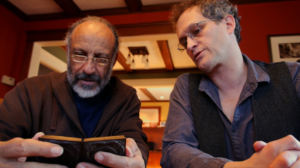Talking about Race
Seeing Race
Seeking transformation through dialogue.
We live in an age of increasing polarization. Blue state against Red state. Rich against poor. Republican against Democrat. Religious against secular. Right against Left. And one thing we find it hardest to talk about, across the divides, is race. The tragedy of George Floyde’s death, if we needed any more proof, has shown us that. Race is perhaps the most divisive social category in America, the one that challenges most deeply our founding principle that all human beings are created equal.
The film “Before the Trees Was Strange” begins with the assumption that we also have reason to hope. Despite the polarization in some arenas, we are an increasingly diverse nation. For the first time in US history, non-white births have exceeded white. The foods we eat, the music we listen to, the public figures we admire, the people we work with, live near, love and even marry — they are all becoming more diverse and more intertwined in our daily lives.
But race remains a stubborn obstacle for us. The history and the pain run deep. Even with all the good will in the world, we don’t know how to get past our fears simply to talk. But if our diversity is to triumph over our divisions, we need to talk, we need to examine our own ways of seeing ourselves and each other. We need to seek transformation through dialogue. We can’t let it fester. The ability to talk about race comes before any policy question, because first we must be able to hear each other, and ourselves, before we can resolve the questions facing us. “Before the Trees Was Strange” will endeavor to seed the ground for that dialogue.
A short film using early American photographs, daguerreotypes, to have a discussion about Race.
Seeing Race
Race. Do you know it when you see it? Can you say what you are seeing? What stories can you tell about race, and what do your stories tell about you? What do our stories tell about us?
Race. The original sin of our nation. Slavery. Discrimination. Segregation. Fear. Separation. Oppression. Our national motto, “E pluribus unum” — Latin for “Out of many, one” — proclaims an ideal: We are, or we should be, united despite our diversity, even because of our diversity. Our differences should make us strong, not divide us.
But race and racism have cut against the ideals of our nation since even before its founding. Seeing through the lens of race, we divide up the world into Us and Other. Race undercuts the aspirations for unity and equality that form the highest ideals of our nations.
But what does it mean to see race? Do you know what you are seeing when you see race? Can you tell what race is, and what does what you think you see, what does what you imagine and say, tell about you?
Mirror of Race encourages us to explore what we see though the use of the earliest of photographs. Visit the site and explore the exhibition here.
Derek Burrows and Gregory Fried started the Mirror of Race project 20 years ago to open up a dialogue about Race in America. Since then the project has grown.

